Machine Learning
In my Master Thesis, I learned and worked a lot with machine learning. The ability of a computer learning by itself still amazes me and this is one of my favorite research topics. In this page, I will present the definition of machine learning as well as a detailed definition and application examples of several machine learning algorithms.
Table of Contents
- What is Machine Learning?
- Supervised Learning
- Unsupervised Learning
- Supervised Learning to Rank for Information Retrieval
- Based on Support Vector Machines
- Based on Neural Networks
- Based on Boosting Theory
- Algorithms Based On Trees
- Algorithms Based on Unconstraint Optimizations
What is Machine Learning?
TODO: intro
Arthur Samuel (1900 - 1990)
Arthur Samuel was an American researcher in the fields of computer games and artificial intelligence. He believed that computers could learn by experience. In 1959, he proposed a the world's first self-learning program: a Checkers-Playing game.
Since many professional checkers players had annotations of what would be examples of good plays and bad plays, Samuel used that data in order to adjust the criteria for his computer program. This was, the computer would only choose the plays that were consider good by expert players.
In his checkers program, Samuel used a search tree with the positions of the board that could be reachable from a current state. The learning function was a score that, based on the position of the board at specific given time, the function would measure the probability of each player winning. His program used as features things like the number of pieces on each side of the board, the number of kings and the pieces that were closed to be kings. The computer program used a minimax strategy. That is, the computer program would always choose a play assuming that the opponent would always choose the play that would give him more advantages (a higher score). Along his game, Arthur Samuel also proposed the first definition for machine learning:
Machine Learning is a field of study that gives computers the ability to learn without being explicitly programmed.
Tom Mitchell (1951 - )
TODO: BIO
In Machine Learning, a computer program is said to learn from experience E with respect to some task T and some performance measure P, if its performance on T, as measured by P, improves with experience E.
Supervised Learning To Rank for Information Retrieval
Information retrieval essentially deals with ranking problems. An adhoc retrieval system checks the documents of a collection and ranks them according to their degree of relevance to a user query expressing the information need. The major difficulty faced by an Information Retrieval (IR) system resides in the computation of these relevance estimates.
Learning to rank for information retrieval is a particular approach to the traditional information retrieval ranking problems. It automatically tunes parameters and builds ranking models through the usage of hand labelled training data (e.g., document collections containing relevance judgements for specific sets of queries), this way leveraging on data to combine different estimators of relevance in an optimal way. The learned raking model can then sort documents according to their degree of relevance to a given query. In the scope of information retrieval, learning to rank (L2R) methods can automatically help to sort documents according to the query topics.
The following figure provides an illustration of the general approach which is commonly used in most learning to rank methods. It consists in two separate steps, namely training and testing.

In this framework, qi (i=1,...,n) corresponds to the set of n queries for the training step, x(i)= { x(i)j }m(i)j=1, with m being the number of documents associated with query qi, are the feature vectors associated to each query and yi (i=1,...,n) are the corresponding set of relevance judgements. When applying a specific learning method to this training set, the system combines the different estimators of relevance in an optimal way, learning the corresponding ranking model. During the learning process, a loss function is applied to measure the inconsistencies between the hypothesis space h and the ground truth label y.
In the test step, the learned ranking model is applied to a new given query in order to sort documents according to their relevance to the information need. The ranked document set is then returned as a response to the query.
Learning to Rank algorithms can be classified into three major approaches: pointwise, pairwise and listwise approaches.
Pointwise Approaches
In pointwise approaches, since the relevance degrees can be regarded as numerical or ordinal scores, the learning to rank problem is seen as either a regression (the relevance degree is seen as a real number), classification problem (the ground truth label is regarded as a quantitative value).
The idea behind the pointwise approach is that given feature vectors of each single document of the training data for the input space, the relevance degree of each of those documents can be predicted with scoring functions, and throughout these scores one can sort all documents and produce the final ranked list. A loss function is applied in order to measure the individual inconsistencies between the scoring function and the ground truth labels. Many supervised machine learning algorithms for regression, classification or ordinal regression can be readily used for this purpose.

The advantage of the pointwise approach is that it directly supports the application of existing theories and algorithms on regression or classification. However, the information order between documents cannot be considered in the training step, because the algorithm receives single documents as input. Since evaluation measures in IR are based in two fundamental criteria, namely query-level and position-based data, this loss of document order information is a major problem, because the evaluation measures which take into account the position of the documents will not be directly optimized and, consequently, the pointwise approach may unconsciously overemphasize unimportant documents.
Pairwise Approaches
In pairwise approaches, since the relevance degree can be regarded as a binary value which tells which document ordering is better for a given pair of documents, learning to rank methods are seen as a classification problem. The general idea behind the pairwise approach is that given feature vectors of pairs of documents of the training data for the input space, the relevance degree of each of those documents can be predicted with scoring functions which try to minimize the average number of misclassified document pairs. The loss function used in the pairwise approach takes into consideration the relative order of each pair of documents.
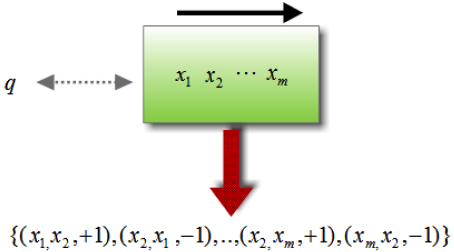
Notice that the classification problem that this approach addresses is not the same as the one addressed by the pointwise approach. In the pointwise approach, the learning method operates on every single document. On the other hand, in the pairwise approach, the learning method operates on every two documents under investigation.
The advantage of the pairwise approach is that it directly supports the application of existing theories and algorithms on classification. However, the loss function only takes into account the relative order of the pair of documents and therefore it is very difficult to derive the order of the documents in the final ranked list.
Listwise Approaches
In listwise approaches, the learning to rank problem takes into account an entire set of documents associated with a query as instances, and trains a ranking function through the minimization of a listwise loss function defined on the predicted list and the ground truth list.
The idea behind the listwise approach is that, given feature vectors of a list of documents of the training data for the input space, the relevance degree of each of those documents can be predicted with scoring functions which try to directly optimize the value of a particular information retrieval evaluation metric, averaged over all queries in the training data. The loss function used in the listwise approach takes into consideration the positions of the documents in the ranked list of all the documents associated with the same query. This is a difficult optimization problem, because most evaluation measures are not continuous functions with respect to the ranking model's parameters. Continuous approximations or bounds on evaluation measures have been successfully used in this task.
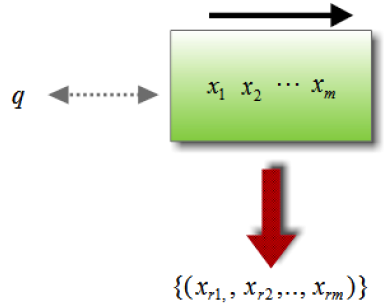
The major advantage that the listwise approach has over the pointwise and the pairwise approaches is that its loss function takes into account the positions of the documents in a ranked list of all documents associated with the query. Since evaluation measures in IR consider the document positions, this approach generally improves the performance.
Algorithms Based On Support Vector Machines
Support Vector Machines (SVMs) can also be defined as learning machines that construct an N-dimensional decision boundary surface that optimally separates data into positive examples and negative examples, by maximizing the margin of separation between these examples. One major advantage is the computational complexity of an SVM, which does not depend on the dimensionality of the input space.
SVMmap
The SVMmap listwise method, introduced by Yisong Yue and Thomas Finley, builds a ranking model through the formalism of structured Support Vector Machines, attempting to optimize the metric of Average Precision (AP).
The general idea of SVMmap is to minimize a loss function which measures the difference between the performance of a perfect ranking (i.e., when the Average Precision equals one) and the minimum performance of an incorrect ranking (i.e., when it is less than one).
The SVMmap algorithm receives as input the parameter $C$, which affects the trade-off between model complexity and the proportion of non-separable samples. If it is too large, we have a high penalty for non-separable points and we may store many support vectors and overfit. If it is too small, we may have underfitting.
Suppose x={xj}j=1m is the set of all the documents associated with a training query q, and suppose that yu,v(i) represents the corresponding ground truth labels. Any incorrect label for x is represented as yc. SVMmap solves the following quadratic optimization problem:

In Equation X, the margin term 1/2 ||w|| 2 controls the complexity of the ranking model w. The method introduces slack variables, ξu,v (i), which measure the degree of misclassification of the datum xi. Each time there is a wrong output $y$, SVMmap requires a constraint. In the constraints, Ψ(y,x) is called the joint feature map, whose definition is:
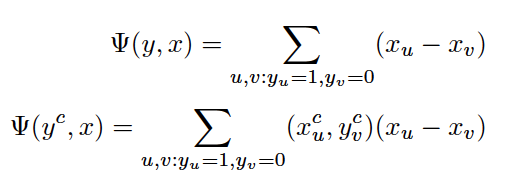
Since there are an exponential number of incorrect labels for ground truths, it is a big challenge to directly solve the optimization problem involving an exponential number of constraints for each query. In their work, the authors suggested the usage of the cutting plane method contained in the formalism of structured SVMs to efficiently tackle this issue by maintaining a working set with those constraints with the largest violation:

SVMrank
The basic idea of SVMrank is to attempt to minimize the number of misclassified document pairs. This is achieved by modifying the default support vector machine optimization problem, which considers a set of documents, by constraining the optimization problem to perform the minimization of each pair of documents. This optimization is performed by Equation X over a set of n training queries {qi}i=1n, their associated pairs of documents (xu (i),xv (i)) and the corresponding relevance judgement yu,v (i) over each pair of documents (i.e., pairwise preferences resulting from a conversion from the ordered relevance judgements over the query-document pairs):
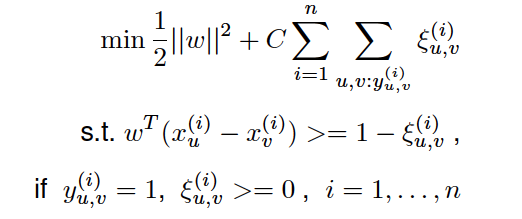
Differently from standard SVMs, the loss function in SVMrank is a hinge loss defined over document pairs. The margin term 1/2||w||2 controls the complexity of the pairwise ranking model w. This method also introduces slack variables, ξu,v (i), which measure the degree of misclassification of the datum xi.
The objective function is increased by a function which penalizes non-zero misclassifications, ξu,v (i), and the optimization becomes a trade off between a large margin, and a small error penalty.
Just like any SVM algorithm, SVMrank receives as input the parameter C which affects the trade-off between model complexity and the proportion of non-separable samples.
Algorithms Based On Neural Networks
Artificial Neural Networks (ANNs) are a machine learning approach that attempts to construct an N-dimensional decision boundary surface that separates data into positive examples and negative examples, through the simulation of some properties that occur in biological neural networks. They require the use of optimization methods, such as gradient descent, to find a solution that minimizes the number of misclassifications.
RankNet
The RankNet pairwise method, proposed by Chris Burges et al., builds a ranking model through the formalism of Artificial Neural Networks, attempting to minimize the number of misclassified pairs of documents.
The basic idea of RankNet is to use a multilayer neural network with a cost entropy function. While a typical artificial neural network computes this cost by measuring the difference between the network's output values and the respective target values, RankNet computes the cost function by measuring the difference between a pair of network outputs. RankNet attempts to minimize the value of the cost function by adjusting each weight in the network according to the gradient of the cost function with respect to that weight through the usage of the backpropagation algorithm.
The RankNet algorithm receives as input the parameter $epochs$, which is the number of iterations which provide the network with an input and update the network's weights, and the parameter hiddenNodes, which corresponds to the number of nodes to be contained in the network's hidden layer. The hiddenNodes parameter has a big impact in the learning process of the network, because if they are too few, we can underfit the data and therefore the network cannot learn any details. On the other hand, if there are too many nodes, we can overfit and therefore the network cannot generalize well and will not be able to predict correctly the value of a document never seen before.
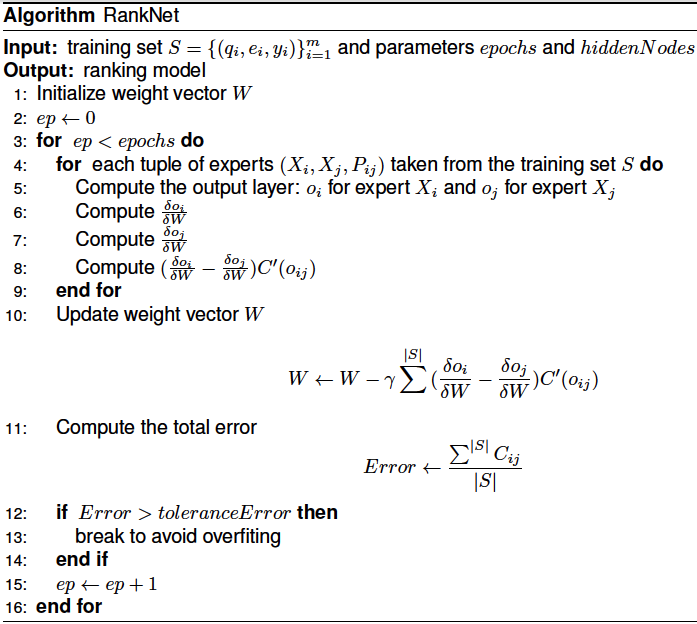
RankNet uses as training data a set of tuples of the form < Xi, Xj, Pij >, where Xi corresponds to the feature vector associated to document i and Xj to the document j. Pij is the probability that document i has a bigger rank than document j. Equation X is a logistic function which is responsible to map the outputs of the network to the probabilities Pij of the documents.

The cross entropy cost function adopted by RankNet is given by Equation X, where Pij is the target values for the posterior probabilities Pij and oij corresponds to the output of the network and is given by oij = f(Xi) - f(Xj).

In order to minimize the error function, RankNet uses a modification of the backpropagation algorithm, where the gradient of the error function is expressed just like in Equation X.

ListNet
TODO
Based on Boosting Theory
Boosting theory is a supervised machine learning approach that iteratively attempts to improve a candidate solution. Boosting theory uses the concepts of weak and strong learners. Weak learners are classifiers that are slightly correlated with true classification. Strong learners are classifiers that are highly correlated with the true classification. The paradigm of boosting theory involves creating a single strong learner through the combination of a set of weak learners.
AdaRank
The AdaRank listwise method, proposed by Jun Xu et al., builds a ranking model through the formalism of the Boosting approach, attempting to optimize a specific information retrieval performance measure.
The basic idea of AdaRank is to train one weak ranker at each round of iteration, and combine these weak rankers as the final ranking function. After each round, the documents are re-weighted by decreasing the weight of correctly ranked documents, with basis on a specific evaluation metric, and increasing the weight of the documents which performed poorly for the same metric.
The AdaRank algorithm receives as input the parameter T, which is the number of iterations that the algorithm will perform, and the parameter E, which corresponds to a specific information retrieval performance measure (in the scope of this work, the MAP evaluation metric was used).
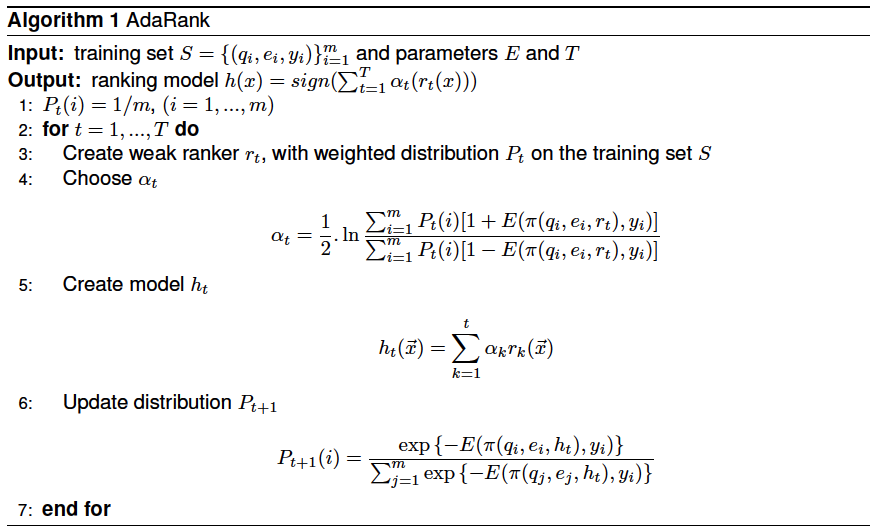
Following algorithm, for each round t, AdaRank keeps a distribution of weights over the queries in the training set. This weight is defined as Pt and Pt(i) corresponds to the weight on the ith training query qi at round t. When the algorithm starts, these weights are all equally distributed over the queries. At each round, the AdaRank algorithm increases the weights of the documents which were not ranked properly by the created model ht. As a consequence, the learning of the following round will be focused only on the creation of weak rankers that can work on the documents belonging to queries which were wrongly ranked.
The quality of the weak rankers is measured by the performance measure E weighted by Pt through Equation X, where π(qi, ei, rt) is the permutation created for query qi, the corresponding set of documents ei and the ranking function rt. AdaRank constructs the weak rankers by using the features individually. That is, the features chosen as weak rankers are the ones which have the optimal weight performance among all the other features. This way, the learning process of the AdaRank algorithm consists of repeatedly selecting features and linearly combining them. When the weak ranker is built, the algorithm associates to the weak ranker a weight αt > 0 which measures the importance of rt.

Algorithms Based On Trees
LambdaMART
The LambdaMART listwise method, introduced by Yasser Ganjisaffar et al., builds a ranking model through the formalisms of boosting theory and regression trees, attempting to optimize a specific information retrieval metric. The basic idea of LambdaMART is to train an ensemble of weak models and to combine the prediction of each one of them in a final model which is stronger and more accurate than a single one. The ensemble is built in stages, where in each stage gradient descent is applied in order to create a model represented by a set of regression trees. Since these boosting tree models can easily suffer from overfitting, the authors introduced regularization parameters which control the number of trees in the model.
The optimization function used in order to improve an Information Retrieval metric is given by the minimization of the error rates. This is performed through an ensemble method, such as Gradient Boosting. Gradient Boosting enables the reduction of the errors by measuring the minimum difference between the learned prediction and the optimal prediction. This means that in each stage, the algorithm is forced to learn more about the documents which were misclassified. Since, in each stage the algorithm is reducing the prediction errors, then it is straightforward the optimization of the scores of information retrieval measures such as Mean Average Precision (MAP).